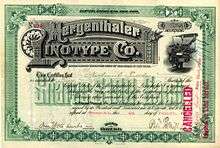Mergenthaler Linotype Company

The Mergenthaler Linotype Company is a corporation founded in the United States in 1886 to market the machine that casts metal type in lines (linecaster) invented by Ottmar Mergenthaler. With the company's primary product, the linotype machine (/ˈlaɪnəˌtaɪp, -noʊ-/[1][2]), it became the world's leading manufacturer of book and newspaper typesetting equipment; outside North America, its only serious challenger for book production was the Anglo-American Monotype Corporation.
Founding
The invention of a machine to replace the labor-intensive task of setting type by hand was one that many inventors had tackled during the 19th Century. The difficulty was not in creating the text, but in returning the characters to a proper position for future use. Mergenthaler solved this problem by placing type molds on the sides of specially keyed matrices. The matrices would be lined up and hot lead alloy forced to fill the matrices, creating the line of type. Then the matrices would progress through the machine, where a special keying system on one end of the matrix, unique for each character, would allow the matrix to drop only into the correct storage slot, ready for future use.
Another problem Mergenthaler solved was in justifying the type, giving flush margins on the left and right. Hand compositors did this by using spaces of different widths in a line, to ensure that the lines all ended at the same point. Mergenthaler adapted the "space band" (patented by J. W. Schuckers), a device consisting of two wedges of metal connected loosely. When a line of type was being justified, all the space band wedges would be pushed up in two passes to spread the line out to the full measure being cast. The space bands were stored for reuse in a different location from the matrices.
History
In 1889, The Linotype Company, a British offshoot of the firm was formed by Joseph Lawrence, publisher of The Railway Magazine. In 1899, a new factory in Broadheath, Altrincham was opened. In 1903, the British company merged with Machinery Trust to form Linotype and Machinery Ltd.
Mergenthaler Linotype dominated the printing industry through the twentieth century. The machines were so well designed, major parts remained virtually unchanged for nearly a hundred years.[3]
The company, as so many in the printing industry, endured a complex post-war history, during which printing technology went through two revolutions — first moving to phototypesetting, then to digital.
During the 1950s, the Davidson Corporation, which manufactured a series of small offset presses, was a subsidiary of Linotype. This was later sold to American Type Founders and operated under the name ATF-Davidson.[4]
Through a series of mergers and reorganizations, the business of Mergenthaler Linotype Company ultimately vested in Linotype-Hell AG, a German company. In April 1997, Linotype-Hell AG was acquired by Heidelberger Druckmaschinen AG. The following month certain divisions of Linotype-Hell AG were spun off into new companies, one of which was Linotype Library GmbH with headquarters at Bad Homburg vor der Höhe. This new company was responsible solely for the acquisition, creation and distribution of digital fonts and related software. This spin-off effectively divorced the company's font software business from the older typesetting business which was retained by Heidelberg. In 2005, Linotype Library GmbH shortened its name to Linotype GmbH, and in 2007, Linotype GmbH was acquired by Monotype Imaging Holdings, Inc., the parent of Monotype Imaging, Inc. and others.
Typefaces
The typefaces in the Linotype type library are the artwork of some of the most famous typeface designers of the 20th Century. The library contains such famous trademarked typefaces as Palatino and Optima by Hermann Zapf; Frutiger, Avenir and Univers by Adrian Frutiger; and Helvetica by Max Miedinger and Eduard Hoffman. Linotype GmbH frequently brings out new designs from both established and new type designers. Linotype has also introduced FontExplorer X for Mac OS X. It is a well reviewed font manager that allows users to browse and purchase new fonts within the program — a business model similar to that used by iTunes and the iTunes Store.
See also
References
- ↑ "Linotype". Merriam-Webster Dictionary. Retrieved 2016-01-21.
- ↑ "Linotype". OxfordDictionaries.com. OUP. Retrieved 2016-01-21.
- ↑ Howells, John; Dearman, Marion (1996). Tramp Printers (1 ed.). Los Angeles: Discovery Press. p. 280. ISBN 978-0-9650979-0-1. Retrieved 23 May 2011.
- ↑ "Davidson Dual-Lith advertisement". Graphic Arts Monthly. September 1955.
- Basil Kahan: Ottmar Mergenthaler – The Man and his Machine; Oak Knoll Press, New Castle (DE), 2000 – ISBN 1-58456-007-X
External links
- Official website
- Linotype – Chronik eines Firmennamens (Linotype – Chronologie of a Company Name): e-book covering the history of Linotype, starting in 1886
- Linotype: the Film
- Typophile: Linotype Article
- Heidelberger Druckmaschinen AG – Official website
- Metal Type — For Those who Remember Hot Metal Typesetting
- Linotypesetting - Hot Metal Typesetting for Hobbyists and the Trade
- The Linotype & Machinery Co. Ltd - information sheet on the UK company from the Museum of Science and Industry (Manchester)